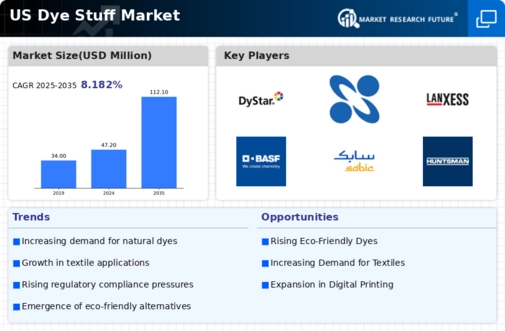The US Dye Stuff Market is characterized by a dynamic and competitive landscape driven by diverse consumer demands and increasing industrial applications. As the market evolves, manufacturers are focusing on product innovation, sustainability, and the development of specialized dyes to cater to the specific needs of various industries, including textiles, plastics, and food. Companies operating in this market are constantly striving to enhance their production processes, reduce environmental impacts, and improve dye quality. These factors create a lively atmosphere for competition, as businesses seek to differentiate their offerings through technology advancements and customer service excellence.
The competitive insights of this market reveal the ongoing trends, market share distributions, and strategies employed by various players to capture a significant share in this lucrative sector.Dystar holds a prominent position within the US Dye Stuff Market, reflecting its robust capabilities and extensive product portfolio. Known for its innovative solutions, Dystar focuses on providing high-performance dyes that meet both aesthetic and functional requirements across a wide range of applications. The company's strong emphasis on sustainability enables it to produce dyes that comply with stringent environmental regulations, thereby appealing to environmentally-conscious consumers and industries.
Dystar's operational presence in the United States is marked by a well-established distribution network that ensures timely delivery and customer satisfaction. Furthermore, its commitment to research and development allows Dystar to remain competitive, adapting to market changes and technological advancements, which consolidates its strength and market positioning in the US.Nippon Kayaku has carved a niche for itself within the US Dye Stuff Market, showcasing a diverse portfolio that incorporates various specialty dyes and chemicals tailored for numerous industries. The company's strengths lie in its quality assurance processes and the continuous enhancement of its product offerings.
Nippon Kayaku is recognized for its innovative approach, offering dye solutions that cater to the stringent demands of sectors like textiles and pharmaceuticals. Its market presence is reinforced through strategic partnerships and collaborations, allowing it to expand its reach and product availability across the US. Notably, Nippon Kayaku's commitment to sustainability and eco-friendly practices positions it favorably among competitors. The company consistently explores opportunities for mergers and acquisitions to enhance its market share, reflecting its proactive strategy to consolidate and expand its operations within the US dye industry.
This approach, combined with its focus on innovation and customer-centric solutions, solidifies Nippon Kayaku's standing in the competitive landscape of the US Dye Stuff Market.





















Leave a Comment